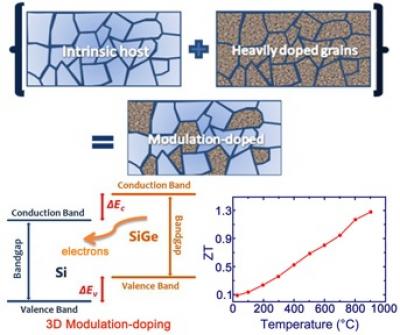Apr
26
Thermoelectric Gains Performance With Better Materials
April 26, 2012 | Leave a Comment
The intense interest in harvesting energy from heat sources has led to a renewed push to discover materials that can more efficiently convert heat into electricity. A team of Boston College and MIT researchers report developing a novel nanotech design that boosts the thermoelectric performance of a bulk alloy semiconductor by 30 to 40 percent.
Using a process known as a 3D modulation-doping strategy, the researchers are finding the gains by re-designing materials that scientists have been working with for years.
Silicon Germanium is valued for its performance in high-temperature thermoelectric applications. The team found by altering the design of bulk SiGe with 3D modulation doping, a process borrowed from the thin-film semiconductor industry, helped produce a more than 50 percent increase in electrical conductivity.
Boston College Professor of Physics Zhifeng Ren and graduate researcher Bo Yu, and MIT Professors Gang Chen and Mildred S. Dresselhause and post-doctoral researcher Mona Zebarjadi paper has been published in the journal Nano Letters.
The 3D modulation-doping strategy succeeded in creating a solid-state device that achieved a simultaneous reduction in the thermal conductivity, which combined with conductivity gains to provide a high figure of merit value of ~1.3 at 900 °C.
Modulation doping is widely used in producing microelectronics and photonic devices such as computer chips and camera and scanner sensors. The purpose is to reduce impurity scattering and enhanced mobility of the doping material.
The team’s innovation to apply the doping to the SiGe enhanced the power factor significantly by using a thirty percent volume fraction of boron doped silicon nanoparticles in the base silicon germanium. The improvement to the power factor signifies a new strategy to improve the electron performance in bulk materials.
The team has developed a simple model based on mixture rules to interpret the experimental data. Without any fitment parameters, the team is able to explain the experimental data within a maximum uncertainty of ± 20%. The team expects that similar modulation-doping strategies can be applied to other thermoelectric materials following the developed general guidelines.
Bo Yu explains the research paradox, “To improve a material’s figure of merit is extremely challenging because all the internal parameters are closely related to each other. Once you change one factor, the others may most likely change, leading to no net improvement. As a result, a more popular trend in this field of study is to look into new opportunities, or new material systems. Our study proved that opportunities are still there for the existing materials, if one could work smartly enough to find some alternative material designs.”
There’s a bonus in the research from a cost standpoint. Professor Ren pointed out that the performance gains the team reported compete with the state-of-the-art n-type SiGe alloy materials, with a crucial difference – the team’s design requires using 30 percent less Germanium. “Using 30 percent less Germanium is a significant advantage to cut down the fabrication costs. We want all the materials we are studying in the group to help remove cost barriers. This is one of our goals for everyday research,” said Ren.
The calculation of the lost energy to escaped heat in the U.S. is about 60%. Or not quite double of what you bought is simply lost. From huge industrial and power generation stations down to the hot water pipes in homes, a stunning loss takes place every time fuels are used. For transportation the numbers are even worse.
How the Boston College and MIT team’s work will translate into products is yet to be seen. But a certainty is the thermoelectric performance is going to improve and costs will start to fall as mass production scales up.


